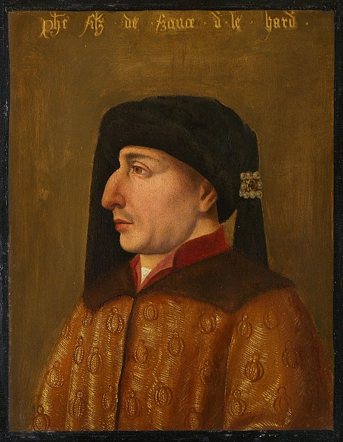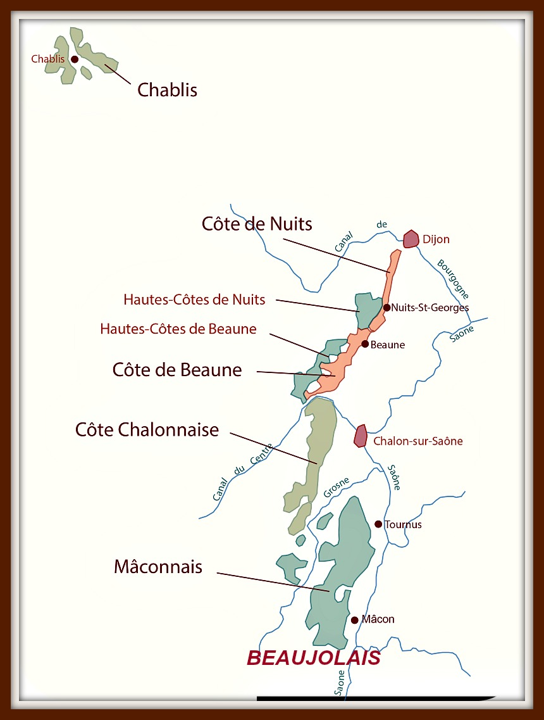
Burgundy has often been named the stomach of France (as Paris is the head, and Champagne is the soul), but I don’t think that such a comparison is correct. If you associate France with the body, then Burgundy is its tongue with all its taste buds. Because Burgundy is not about gluttony, it is about enjoyment. Enjoyment of meal, enjoyment of wine. For this Burgundy has everything. As Burgundians say – it is an Epicurean place. Burgundian wines are famous around the world.

Burgundy is a remarkably interesting wine region, with a huge (more than 2000 years) and well-documented winemaking history, and with a long list of people who invested their time, hard work, and souls into the wine glory of the region for centuries.
The Celts started to grow grapes on this territory in the first century B.C. At the time of the Roman Empire Burgundian wines became known outside the region which definitely means something: transportation was so difficult in those times that people transported the only things that were really worth it. The earliest recorded notes about Burgundy wine were written in the 6th century by the historian and bishop Gregory of Tours, who compared it with famous Roman Falernian wine. However, the real winemaking development started in 910, when the Benedictines owned many vineyards on the Burgundy hills for their Cluny Abbey. Benedictine’s contribution to winemaking all in all, and France’s winemaking in particular is invaluable.
In 1098, the Cistercians joined the Benedictines on the winemaking field. They created vineyard Clos de Vougeot that now produces one of the best Burgundy wines and qualified as Grand Cru. That is especially important, they were the first to notice that different vineyard plots consistently gave different wines. They laid the earliest foundation for the naming of the Burgundy crus and the region’s terroir thinking.
The idea of terroir, when each geographical region with a unique microclimate, soil, geology and so on, produces its own wine that reflects all these regions’ peculiarities, was born in Burgundy. The unique geography of Burgundy, where every slope has its own terroir, brought an important impact. Since the 12th century, the vineyards of Burgundy were divided into climats, the plots with specific terroir. In the 16th century, the climats system was completely developed, and every such plot produced its own wine. Actually, the climats is a basement of the modern Appellation d’Origine Controlee system (about the AOC system read here). Nowadays about 1200 climats, certified as AOCs, exist. Burgundy with its climats was inscribed on the UNESCO World Heritage List, because of its historic significance and importance for viniculture development.
By the way, early climats were often surrounded by man-made walls (some such stone walls exist now). Such climats is called clos, which is reflected in the names of many AOCs (same Clos de Vougeot).
In 1855 all Burgundy vineyards were classified. The best got Grand Cru title (1% of all region wines), next level – Premier Cru (11%), next level – Villages (23%), and next level- regional wines. Because of the specific winemaking organization in Burgundy (that I am explaining below), sometimes the real quality of AC Villages wines can be better than Premier Cru. Grand Cru is an exception, but they are very expensive.
In 1936 Burgundy started to classify its vineyards according to the AOC system (about AOC classification in France read here). Because Burgundy has the most terroir-oriented classification in France, and because its terroir is very complex, it has more AOCs than any other region. This makes the orientation in the ocean of Burgundy wines a little bit complicated.
Burgundy is the most fragmented French wine region. Vineyards are exceedingly small, and even small vineyards can have several owners who make wine independently. For this, we should say thanks to Napoleon. After the French Revolution vineyards were taken from the Church, broken up and sold. Napoleon also changed inheritance so that all family members shared equally.
Such fragmentation unescapably gave rise to wine négociants’ appearance. They brought barreled wine from small owners, blended it, aged it, bottled it, and sold it. Even now, about 60% of Burgundy wine sells by négociants. As a result, when you are choosing the bottle of Burgundy wine (if it is not Grand or Premier Cru) pay attention to the négociant name (it certainly would be on the bottle label in contrast to the vineyard name) and to their reputation. Bouchard Pere et Fils, Joseph Drouhin, Faiveley, and Louis Jadot traditionally have good reputations. Bichot, Boisset, Chanson, and Pierre Andre raised their reputation recently.
Burgundy produces mainly single-varietal wines, giving the grape opportunity to show its best sides, and also showing the terroir influence on the wine taste.
Two grape varieties inseparably connected with Burgundy – Chardonnay (read my article about Chardonnay) and Pinot noir (read my article about Pinot noir). They originated and developed in Burgundy, and brought her the wine glory. Chardonnay and Pinot noir are the main varieties grown in Burgundy now.
Half of Burgundy grapes are Chardonnay. Winemakers of Burgundy not only created the variety, but they also originally applied all red wine techniques to the wine. They created the soul of Chardonnay. Of course, not all Burgundian Chardonnay is perfect, but the best Chardonnay comes from Burgundy.

40% of the region’s grape is Pinot noir. Some rulers of Burgundy also made huge contributions to the development of region winemaking and, especially, to Pinot noir’s rise. During the 14th and15th centuries the region was under the rule of the Dukes of Burgundy. At the beginning of this period, Pinot noir did not dominate regional vineyards. The main variety among red grapes was Gamay. Gamay is an easy-growing grape compared to Pinot noir; it does not require so much care and produces more fruits. At the same time, it gives quite simple wine, much less interesting and complex than Pinot noir. In 1395 Duke Philip the Bold issued a decree that the only red grape allowed to be planted was Pinot Noir. The use of the Gamay grape was declared unfit for human consumption and prohibited. Gamay was pushed out to Beaujolais, and now it is the main variety of this region.

By the way, the Beaujolais region formally belongs to Burgundy, however, many wine specialists prefer to consider it as a separate wine region. I completely agree with this approach – these regions are so different that it is not worth combining them.
Nowadays some Gamay is grown in Burgundy only in the Macconias region, which specialises in Chardonnay, and in two other small AC, where it blended with Pinot noir. So, except for those places, the red Burgundy is Pinot noir.
The replacement of Gamay with Pinot noir was not the only wise decree of Duke Philip the Bold (of course, I am talking only about wine-concern things). He forbade the use of manure as a fertilizer as it lessened the quality of the grapes. He was absolutely right. Such vine fertilization increases the crop yield that diluted the quality of the wine made.
Interestingly, Burgundy winemakers made the same mistake in the 1900s, when chemical fertilizers became widely accessible. Fortunately, they soon recollect themselves, and in the 80s the taste of Burgundy wine returned to normal.
Back to varieties of Burgundian land. Although Chardonnay and Pinot noir covers 90% of all regional grapes, other varieties also can be found here. 6% belongs to Aligoté, another variety that originated from Burgundy. It has its own AOC – Bourgogne Aligoté AC.
The rest is covered with Sauvignon Blanc and Gris (for them АОС Saint-Bris), rare Burgundian variety Melon de Bourgogne, and also Cesar, Gamay, and some other varieties.
From all this grape Burgundy makes white wine (60%), red wine (28%), a little bit of rose (0.5%), and sparkling Crémant de Bourgogne, which has its own AOC (what Crémant is you can find here).
The region elongates from the north to the south and is divided into four sub-regions – Yonna with its famous Chablis (about Yonna in details here), Cote d’Or (that combined Cote de Nuits and Cote de Beaune), Cote Chalonnaise and Maconnais. I will talk about them separately.